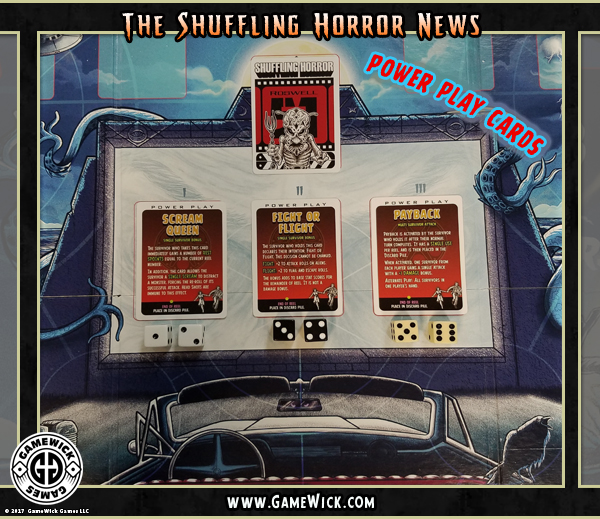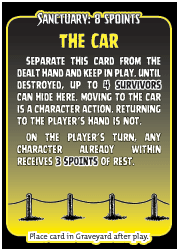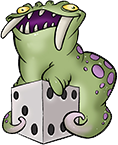October 27th, 2017
Roswell 51, Shuffling Horror FAQ
Here’s a tip for Shuffling Horror: Roswell 51 game set-up. The Roswell 51 movie deck includes three Power Play cards (the red colored cards in the deck). These cards benefit the players and only two Power Play cards should be used for play. Including all three Power Play cards in the movie gives the survivors a significant advantage!
Before the game begins, the Director can set these up in the three slots on the movie screen (as shown below), and then roll a single die to randomly determine which to exclude. Rolling a 1 or 2 eliminates the first card, 3 or 4 the second, 5 or 6 the third. In this way, the players will know how the deck is stacked. The remaining two cards are then shuffled into the deck and the movie can begin!

If you have any questions on game set-up or rules, feel free to contact us.
Stay tuned for more Shuffling Horror playing tips!
See More »
September 30th, 2017
Roswell 51, Shuffling Horror FAQ
The Robot is one of the twelve survivors in Shuffling Horror: Roswell 51. Two rules define the Robot’s special powers and make it stand apart from the human survivors (it is the only character card with rules noted on it). Since the game’s release this summer, a few players have contacted us regarding these abilities.

Starts With 6 Spoints
Whenever the Robot enters play, it automatically begins with six spoints (survivor points). This even occurs if the Robot is a player’s starting character (starting characters never begin with spoints; the Robot is the only character who breaks this rule). The same applies if the Robot is drawn as a secondary character, it immediately gains six spoints (whereas all other characters only gain three). In this way, the Robot always begins stronger than the humans it protects and serves. The spoints represent the Robot’s superior strength and intellect.
Armor: Use Muscle For Flail Tests
Like most robots in 1950s sci-fi flicks, the Robot is covered with protective plate armor. Similarly, the Robot is not known for its speed (this is the reason the Robot has no SPEED score). The Robot lumbers forward making all of its flail checks (defense rolls) versus its high MUSCLE score (an 8).
And, yes… The Robot can be spored just like all other survivors in Shuffling Horror: Roswell 51. As the rulebook notes, such a demise is treated as if the aliens have altered its programming to destroy all humans…
See More »
March 12th, 2014
Pittsburgh 68, Shuffling Horror FAQ

It has been confirmed – the zombie outbreak has hit New Zealand! A Zombie Master there sent us an email regarding the game’s Sanctuary cards. In Pittsburgh 68, there are two Sanctuary cards: The Car and The Cellar. Both provide shelter for the survivors to rest – but these may not last long as they are subject to zombie attacks once they become occupied with “fresh meat”.
 Here are the questions from Brett in New Z-land.
Here are the questions from Brett in New Z-land.
“Is it a Player action or Survivor action to enter a sanctuary?”
Answer: Move is a survivor action (p8); if a player has multiple survivors in play, one or all can be moved into the sanctuary. A player is free to act with those who don’t move. There are only two Player actions that prohibit multiple survivor actions: Reveal and Take+Attack.
“It is unclear as to what survivors can do in the shelter. Can they take an action or do they miss their action to gain the spoints?”
Answer: A survivor forfeits their action to gain spoints (p3). A survivor cannot act or attack while in a sanctuary – they are hiding/resting. Taking the spoints commits that survivor to staying in the sanctuary until the player’s next turn. If they choose NOT to take the spoints, the survivor freely returns to a player’s hand and may immediately act. The MOVE into the sanctuary is an action, the return is not.
 “It seems that the spoints gained from a sanctuary are general spoints not character spoints. Is this correct?”
“It seems that the spoints gained from a sanctuary are general spoints not character spoints. Is this correct?”
Answer: No, sanctuary spoints are character spoints. The only general spoints in the game are the seven that each player starts with (p4). All spoints gained after the game begins (via Rest) are character spoints and placed on that survivor’s card.
“The plot device card “Run For It” affects all survivors in play and if a survivor fails the check they get attacked by a zombie. Survivors in sanctuaries are affected by plot devices but can’t usually be attacked. Can they be attacked in this case if they fail the check?”
Answer: Yes, they can be attacked. Run For It is the only Plot Device card that affects every in-play survivor, even those in a sanctuary. When we play Pittsburgh 68 at game conventions we explain that Run For It triggers the scene in the movie where the survivors forgot to check that one closet in the room or don’t to look in the back seat of the car… While they thought they were safe, they suddenly discover they have a zombie problem in their hiding spot. Run For It is a short-lived zombie attack but critical to allow the zombies a breaching point.
Thanks for the questions and keep on shuffling!

See More »
August 8th, 2013
Pittsburgh 68, Shuffling Horror FAQ

“How Many Items Can A Survivor Hold?”
A frequently asked question during intro convention play.
The answer is found under Players Hand on page 4 of the Pittsburgh 68 rulebook: “A Survivor Player can have three survivors in-play, each of whom can hold two additional cards (Item or Power Play).”
This means that a single Survivor can hold both The Axe (an item) and The Killing Machine (a power play card). That is a particularly brutal combo in the hands of The College Guy. A Survivor can also hold two Items, though can only use one per action. Damage from items does not stack (another frequently asked question).
The ability for a Survivor to hold two items lets them stockpile weapons, perhaps for the future use of other Survivors who appear later in the game. A Survivor can TAKE and item from another Survivor (if that player allows). A Survivor can never TAKE+ATTACK from another Survivor (otherwise a weapon, such as The Revolver, would just be passed from Survivor to Survivor to Survivor).
Oddly enough, in all the convention games we’ve played, we have yet to see a single Survivor hold both power play cards (The Scream Machine and The Killing Machine). The Killing Machine is best paired with a weapon, though…
With only two slots per Survivor, some tough choices are ahead.
See More »
May 3rd, 2013
News, Pittsburgh 68, Shuffling Horror FAQ, Shuffling Horrors
You’ve seen it in every zombie flick: a zombie latches on to a hapless Survivor who can do nothing but try to shake the undead thing off. This was cleverly done in a finale episode of the Walking Dead; Andrea backs up against a stand of trees to hide from the Governor, suddenly a zombie reaches through and pins her there. Meanwhile, more zombies close in for din-din!

The zombie clutch is a classic move and one that builds dread for its victim. It’s the same in Pittsburgh 68 with the Clutch card (which has the appropriate tag line “Get it off of me!”). And just like in a zombie flick, bystanders can help you escape – if they desire. In game terms, this “help” comes in the way of spoints (Survivor Points) that other players can give you to help you with your FLAIL roll.
But just like in a zombie movie, maybe the other Survivors don’t want to get that close to the zombie… Or maybe your character deserves it… Or maybe, you are just not worth the spoint!
In the game, the Survivor is trapped until they succeed a FLAIL test (roll two dice and get their Speed score or less). Spoints are spent to increase your Speed, so using them can put the odds of escape in your favor. But there’s that rub again – is it worth the spoint?
These are some of the tough decisions you will face in a real Zombie Apocalypse, friends!
Luckily in the game, the Survivor is in no real danger. They are not being attacked, just clutched. It’s the other zombies they need to worry about – but that’s everyone’s problem in Pittsburgh 68. Some options for the player who falls victim to this are:
–If the player has multiple Survivors in play, they can still act with their other Survivors. This lets the player attack with their non-clutched Survivors, while still flailing with their clutched Survivor.
–If a player does not have multiple Survivors, being clutched gives them a good reason to REVEAL another Survivor in their hand (instead of wasting a turn to potentially fail their flail).
The good news (and this is important to remember): the Clutch card disappears at the end of every reel. It does not last the entire game! Like Power Play cards (good cards the Survivors take), the Clutch card is shuffled back into the Dead Pile (discard pile). It may show up again. It may not.
–Determining a Random Victim: When the Clutch card appears, it is the Zombie Master’s job to determine who is clutched. The best way to do this is to assign each in-play Survivor a number, and then roll a die to see who the lucky victim is. Do not roll two dice for a larger group, as a single die gives everybody an even chance.
–As noted in the Pittsburgh 68 rulebook, if there are more than 6 Survivors in play, separate them first into two smaller groups (one is odds, the other is evens). Then roll a die to determine from which group (odds or evens) that the victim will be selected. Finish by rolling a die to see who in that group is clutched.
The best news is that there’s only one Clutch card in the deck. Because of the random nature of the game, Clutch may never show up at all – so, appreciate when it does…
The Zombie Master sure will!
See More »







 Here are the questions from Brett in New Z-land.
Here are the questions from Brett in New Z-land.




